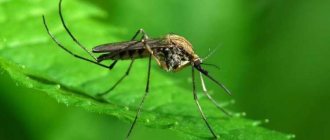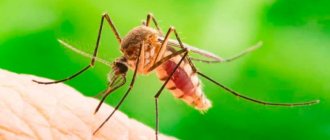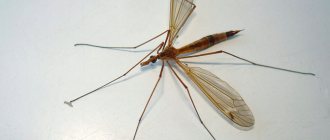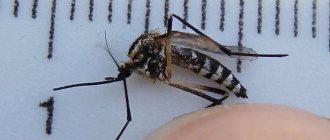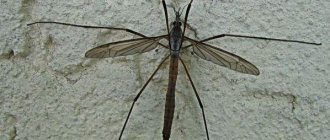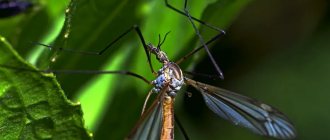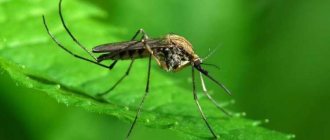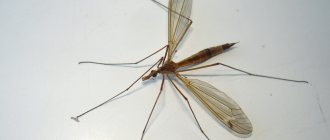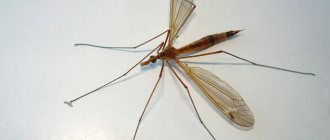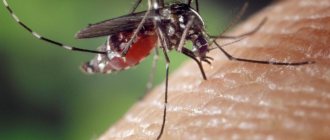Mosquitoes are small two-winged insects distributed throughout the world. In nature there are 3 thousand of them, and in Russia there are 100 species. All are characterized by a piercing-sucking structure of the oral apparatus and complete transformation. The squeak mosquito is the most common species in the temperate zone. The female needs blood feeding to lay eggs. It bites humans and warm-blooded animals. Mosquitoes are carriers of dangerous infections and parasites. The introduction of saliva into the wound leads to the development of allergies and eczema.
Mosquito jerk
The bell mosquito, or jerk, represents the order of Diptera and belongs to the chironomidae family.
These are insects with long legs that usually form numerous flocks and swarm near damp places or flock to a light source. Surely each of you who spent the summer relaxing at the dacha saw the bells circling in the summer air and filling the silence with their endless squeaking. In such flocks there are mainly males and are absolutely safe for humans and animals, since the ability to bite is not inherent in them. When sitting on some surface, they put out their front legs, their body freezes, but their paws constantly twitch. This is where their name comes from.
Features of existence
Being in the water in the form of larvae, these insects are the favorite food of some species of fish.
Such larvae can be found in bodies of water with stagnant water and a bottom covered with silt. They move in the water using special movements - like a snake, bending and unbending their back muscles, now to the right, now to the left. They slowly crawl along the bottom, clinging to surrounding plants and objects with their legs. The larva breathes on the surface of the body, and its coloring is due to a special phenomenon - its blood is saturated with hemoglobin, which is unusual for most insects. It is the bright red pigment that absorbs oxygen, which the larva gradually consumes.
The larva of the jerk lives at the bottom of the reservoir in which the female laid her eggs. It is packaged in a kind of cocoon in the form of a tube, which itself is built from silt and its own salivary glands. In order to rummage in the mud in search of food, the larva sticks its head end out of the tube and, when satiated, hides again in the muff.
Over time, pupation occurs. The bell's pupa has tracheal gills, which are presented in the form of bush-like bundles. At this stage, they do not swim anywhere and do not move along the bottom, but only motionless “hang” in the water, still being inside their clutch. Before rising to the surface of the reservoir, the body of the pupa is filled with air. This air cushion pushes it out of the water, the tube bursts and an insect with wings appears.
Squeaker mosquito
The body color is yellow, brown or gray. The chest is wider than the abdomen, consisting of 10 segments. The limbs are thin and long, there are 2 claws on the paw. Insects have only two fore wings, the hind wings are reduced. The transparent wings along the veins are covered with scales. The abdomen is covered with brown scales, on the underside there is a band of light yellow scales. The proboscis of the male squeaker mosquito has long hairs.
How does development happen?
The period of growing up is accompanied by molting and an increase in size. The network contains photographs of the larvae of the squeak mosquito. They resemble small worms or caterpillars, which can have a different structure or color. The abdomen of the bloodsucker includes 10 segments.
To see how the larva of a blood-sucking mosquito develops, it is not necessary to use literature or visit specialized sites. You can find them in containers containing old water in the summer. Small worms concentrate at the top. If you lower a stick or other object into the water, they will go deeper in order to hide. These mosquito larvae and bloodworms have a certain supply of oxygen, so they can stay at the bottom for 10-15 minutes.
The transformation of a bloodworm into a pupa of an ordinary mosquito occurs after a certain period of time. The pupae are similar to tadpoles, but their colors are different. They move quickly and sometimes jump.
Life cycle
The lower part of the eggs is equipped with a special “hatch”. After 2-8 days, larvae emerge from the clutch. They need to gain strength and grow up. To do this, the newborn bloodworm feeds on protozoa, single-celled algae and bacteria. The body length of the larvae is only 1 mm. In the tail part there is a breathing tube with which they pierce the surface of the water and absorb atmospheric air. How many legs does the squeak mosquito have in its larval stage? Yes, they simply don’t exist! The slightest threat - and, wriggling its whole body, the bloodworm will hide in the water column.
In three weeks, the larva goes through 4 stages of molting. Their body increases in size to 8-10 mm, lengthening 8 times. After such metamorphoses, which are also accompanied by internal changes, pupae appear. They are sometimes called “devils” due to the presence of two respiratory processes in the head. Externally, the bloodworm looks like a tightly coiled worm, reminiscent of a comma.
The next stage of development ends in a week. Having shed the skin of the pupa, the mosquito spreads its wings and takes flight.
Differences between midges and mosquitoes
Midges and mosquitoes
Midges, like mosquitoes, prefer to live near bodies of water where they lay their eggs. But unlike female mosquitoes, the midge is capable of laying thousands of eggs during its short life of 1 month. This fecundity makes midges a worthy rival for squeakers.
To form offspring, midges need blood, which they receive as a result of biting the skin and licking the blood released from the wound. Midges do not transmit diseases and do not lay eggs under the skin of humans, as some types of flies do. But the painfulness of the bites and spoiled outdoor recreation made them enemies for people.
After breeding, midges tend to disappear, since their main purpose in life is fulfilled. And eggs laid in a river or stream independently form into an adult.
Habitat and lifestyle
Every person has had to wake up from the bite or annoying squeak of mosquitoes. This suggests a conclusion about their predominant way of life. Insects prefer to get food at night, and during the day they hide in dark shelters - among the grass, in cracks in the bark of trees.
The closer the river, swamp, lake, the greater the likelihood of encountering countless hordes of squeakers. This is due to their life cycle, part of which takes place in the aquatic environment. Parasites are ubiquitous. You will not find them except in the Arctic or desert, where they cannot reproduce.
During the winter, the parasite prefers to hide in the basements of residential buildings. The presence of small puddles and warmth allows them to “spend time productively.” The pupae develop into an adult, which flies into people's homes in search of food.
Lifestyle
The habitats of the squeak mosquito are coastal areas of water bodies, forests, forest-steppes, and urban areas. Adults settle near water, in basements and attics. In hot tropical regions, mosquitoes are active all year round. In areas with a temperate climate, insects enter diapause during the cold period. Only the female overwinters. Having settled in heated basements, mosquitoes can be active and breed all year round.
Males and females feed on plant nectar and various syrups. They are often spotted on sugar and sweet foods. Insects have weak wings and cannot fly in windy weather. In temperate climates, mosquitoes are active from May to October, but appear earlier in warm weather. How long a squeak mosquito lives depends on several factors:
- floor;
- amount of food;
- climatic conditions;
- natural enemies.
Favorable conditions (low temperature, sufficient food) can prolong the life of the female, and the male's life is limited to 18-19 days. Females of the summer generation live 1-2 months, females of the spring generation – up to 4 months. Moderate temperatures promote longevity:
- 25° - 42-43 days;
- 20° - 55-58 days;
- 10-15° - up to 120 days.
Reproduction
Young adults drink plant juice after emerging from the pupa. Females do without blood until it is time to reproduce and lay eggs. In the evening, in warm weather, you may notice mosquitoes swarming. It is observed near bodies of water, in meadows, near the crowns of trees or bushes, on paths. A cluster of insects moving in a vertical position facilitates the meeting of different-sex individuals. Males identify partners by sound and mate.
After fertilization, the female looks for a victim; she can drink blood from a bird, animal, or person. Blood serves as a source of beneficial nutrients necessary for the development of strong offspring. In search of a power source, she travels 5-12 km. The next step is to find a place suitable for laying.
The female lays from 20 to 200 oblong eggs, glued together in the form of a boat or raft. They do not drown and float freely on the surface of the reservoir. At first the masonry is white, then it darkens. Buoyancy is provided by the special shape of the egg. One end of it is wide and blunt. Laying is done every 2-3 days. In warm weather (23-25°), the embryo develops in 3-5 days. The larvae stay near the surface. In the first days of life, they are especially vulnerable and become victims of numerous aquatic predators.
Most of the larval stage is spent upside down. In this position, it hovers near the surface, filtering water with its oral appendages and swallowing algae, ciliates and rotifers. Having emerged from the egg, the larva has a body length of 1-2 mm; before pupation it reaches 6-7 mm. She goes through 3 molts and 4 instars.
Anatomy
The mosquito insect is distributed throughout the world, there are more than 3000 species, 38 genera. All have a similar structure, but differ in body size. They write a lot about mosquitoes in various sources; they study insects at school. The body structure is simple - head, chest, abdomen.
Head structure
The mouthparts of a mosquito deserve special attention. Includes upper, lower elongated lip, jaws. Inside the lips there is a groove with 12 needles. The jaws and tongue create a cavity for the passage of saliva.
One pair of long spines has projections called teeth. There are 50 of them in total. The insect tears the skin with its teeth. The next pair of needles acts as forceps and holds the wound open. The remaining needles hold the mosquito's proboscis and facilitate the flow of food. The long nose does not go completely under the skin, but reaches the blood vessels.
Female mosquitoes feed on blood. The insect injects saliva, which contains an anticoagulant that thins the blood. This prevents lymph from clotting and ensures a long supply of food. At one time, the female is capable of drinking about 5 ml of blood, with her own weight of 3 g; the number of bites depends on the behavior of the victim. The long nose of the male mosquito provides it with food from flower nectar and pollen.
The eyes are located on the sides of the head. Allows mosquitoes to see in infrared color. Thanks to this feature, insects determine the location of the prey by the outgoing heat. An infrared cloud forms around the body.
The structure of a mosquito's head
The mosquito's whiskers have a unique complex structure. Consist of 15 departments. Insects detect odors at a distance of up to 30 m, according to some reports – up to 1 km. The female clearly smells carbon dioxide, lactic acid, and sweat. Males are guided by the scent of flowers. The structure of the antennae differs between female and male individuals. In males they are made in the form of a brush, in females - in the form of twigs.
The mosquito does not have a brain, but throughout its body there are many nerve intertwinings that allow it to collect and analyze information and coordinate instincts.
Mosquito wings
The oblong transparent wings consist of transverse and longitudinal veins. Swing up to 30 mm. The other pair of wings is underdeveloped, serves as a guide, helps insects stay in the air, hovering for a while. The halteres create a certain squeak during flight, which indicates the presence of an insect. The special structure of the wings allows an ordinary small mosquito to cover a distance of 1 km; according to eyewitnesses, insects rise up to the 9th floor.
The surface of the wings is covered with small scales; the hind wings have a fringe. The flapping frequency in flight is 1 thousand times per second
During the mating period, the female flaps her wings more intensely, creating a certain sound - a squeak, which attracts the attention of males
With the help of a modified frequency of strokes, the fertilized insect makes it clear to the opposite sex that it does not require their attention.
The mosquito's legs are long, thin, only 3 pairs. All the same length. They hold the body in an upright position, as well as on any surface - smooth, slippery, liquid, hard, rough. The legs consist of a coxa, trochanter, femur, tibia, and tarsi. One pair ends with claws, all the rest with small suckers. Spikes are placed on the inner thigh.
Abdomen
Divided into 10 segments, the last 2 form the genital organ. At the end of the abdomen, up to 150 eggs mature at a time. From the second to sixth segments there are simple spiracles that form the mosquito's respiratory system.
The elastic cover allows the body to expand during pregnancy and absorb food. The color of the abdomen is gray, brownish. After feeding on blood, it acquires a characteristic red tint. Body size from 3 to 40 mm, depending on the species.
The heart of a mosquito is presented in the form of an elongated tube. Located under 1-7 segments of the abdominal cavity. Closer to the chest it passes into the aorta. Each segment of the abdomen has striae with valves that provide oxygen supply. The heart accelerates blood in different directions, supplying organs and tissues with nutritional components.
Breast
Consists of 3 segments, externally looks like a single whole. The most developed part is the middle part, to which the wings are attached. It also contains all the flight muscles. There are spiracles in the chest, where the metanotum plays a special role. Legs are attached to the segments.
The anatomy of a mosquito is well studied, as is its internal structure. However, the flying abilities of insects never cease to amaze. Pests are found on 50 floors of a multi-story building. To search for a food source, the female flies non-stop for 1 km. Calmly crosses the pond.
Mosquito diet
This mechanism makes it possible to detect the presence of a female during the mating season, because the male does not need to search for a victim at all. Its main diet consists of natural sugars. Mosquitoes find them in the nectar of burdock, tansy and other field herbs. The female's diet includes two components - in the period before mating, she eats like a male.
After mating dances, the insect becomes a real scourge of warm-blooded animals, looking for them to get enough blood. The squeak mosquito, whose six limbs allow a mature individual to sneak up on the victim unnoticed, can have a different body color, which contributes to its good camouflage. Representatives of the species, which have a brown tint, are barely visible on the bark of trees, and striped individuals are perfectly hidden among the grasses in the undergrowth.
History of discovery
People have always known about mosquitoes, but this species was first scientifically described by Carl Linnaeus in 1758. Later in 1775, Forscal described the same species in Egypt under the name Culex molestus. They both bear close physical resemblance to each other, and scientists later agreed to distinguish these mosquitoes by their willingness to bite people. Culex molestus was more abundant in Alexandria, Rashid and Cairo. Ficalbi
) in 1890 proposed to call the squeaking mosquitoes that bite people “haematophagus”, and those that do not bite people, but feed only on nectar, to be called “phytophages”
Thus, in relation to Culex molestus, partial attention was paid to the degree of biting people; later their behavior was designated by the term “anthropophiles”
The siphon is located on the eighth segment of the abdomen and serves for breathing air. At the end of the siphon there are valves that close when the larva is immersed deep in the water. The larva moves thanks to the caudal fin on the last, ninth segment of the abdomen, consisting of setae.
Lifespan of a mosquito
The main period of insect life is summer. The lifespan of a mosquito depends on a number of conditions:
- Environmental temperature has a great influence on the development and life of insects. The most optimal range is from 10 to 15°C. The female lives in such conditions for about 3-4 months. At a temperature of about 20 degrees, its life expectancy in the absence of other harmful factors will be 2 months. If the temperature exceeds 25° above zero, the female will live no more than 40 days. In similar conditions, the male lives 2 times less than the female.
- Where mosquitoes live, humidity plays an important role in creating favorable conditions for their development. That’s why insects so often choose damp basements, cool utility rooms, and pantries as their home. This is where you need to look for their clusters, trying to find out where the mosquitoes come from.
- The availability of food is an important aspect for maintaining insect life. The mosquito menu depends on gender. Males feed on plant foods - nectar and plant juice. Females need a constant source of blood. It can be a person, an animal, an amphibian, or even a fish.
- Natural enemies that feed on mosquitoes have a direct impact on the insect's life cycle. They are birds, other insects, and insectivorous animals. Humans also contribute to shortening the lives of bloodsuckers.
Under ideal conditions, a female mosquito can live for a whole year, surviving the winter in a state of torpor. It is not difficult to calculate how long an ordinary mosquito lives in real conditions. Typically, the life of a female lasts no more than 40 days, and males die after 20 days.
Scientific research has shown that the life expectancy of a mosquito is influenced by the following factors:
- floor;
- nutrition;
- habitat temperature;
- habitat.
As a result of research, it turned out that the life expectancy of a male is half that of a female. Why this happens has not yet been found out. However, the fact remains. If a mosquito feeds fully, then, naturally, its lifespan is extended. Males feed exclusively on plant nectars, but females do not recognize this type of food
They need blood, no matter whose, animal or human.
They have a special desire to drink blood after fertilization. However, they need blood not just to satisfy their hunger, but in order to breed. If the female is not satisfied after fertilization, this does not mean at all that she will not produce offspring. There will be offspring, but they will be very small and weak, and the female, having given “all of herself” to the offspring, dies. But if the female is satiated, then she will not only breed offspring, but will also remain alive.
Living temperature also affects the lifespan of these blood-sucking insects. The lower it is, the longer their life. So, at an average air temperature of 25 °C, the life expectancy of a female is 42 days; at a temperature of 10 °C, it can reach 115 days. Moreover, in both cases, males live half as long.
It is worth noting that now we were talking about the full life cycle of a mosquito, that is, from the egg state to reaching the “imago” stage - a full-fledged adult that is ready to mate and breed offspring.
If a female mosquito does not drink blood, all her vitality will be spent on producing offspring, and she herself will die
Nutrition of plant sugars
Insects choose certain plants to replenish their vital reserves:
- tansy;
- burdock;
- yarrow.
Most of all they love tansy; 10 individuals gather on a flower at once. An interesting fact about mosquitoes was published by foreign researchers: virgin females prefer plant foods. There were no more than 45% pregnant. Fructose has a beneficial effect on the body of insects, so they need plant foods.
Lifestyle
The habitats of the squeak mosquito are coastal areas of water bodies, forests, forest-steppes, and urban areas. Adults settle near water, in basements and attics. In hot tropical regions, mosquitoes are active all year round. In areas with a temperate climate, insects enter diapause during the cold period. Only the female overwinters. Having settled in heated basements, mosquitoes can become active and...
Males and females feed on plant nectar and various syrups. They are often spotted on sugar and sweet foods. Insects have weak wings and cannot fly in windy weather. In temperate climates, mosquitoes are active from May to October, but appear earlier in warm weather. How long a squeak mosquito lives depends on several factors:
- amount of food;
- climatic conditions;
- natural enemies.
Favorable conditions (low temperature, sufficient food) can prolong the life of the female, and the male's life is limited to 18-19 days. Females of the summer generation live 1-2 months, females of the spring generation – up to 4 months. Moderate temperatures promote longevity:
- 25° - 42-43 days;
- 20° - 55-58 days;
- 10-15° - up to 120 days.
Negative conditions for the existence of dipteran insects are drought, temperatures below 8°, at which they lose activity and stop feeding. In autumn, the last copulation of insects occurs. The males die, and the females search for winter shelter. They hide in cracks, under the bark, deep into the litter. City mosquitoes get into people's homes. If they find a suitable damp basement or container of water in a heated building, the reproduction cycle will not be interrupted for the winter.
Reproduction
Young adults drink plant juice after emerging from the pupa. Females do without blood until it is time to reproduce and lay eggs. In the evening, in warm weather, you may notice mosquitoes swarming. It is observed near bodies of water, in meadows, near the crowns of trees or bushes, on paths. A cluster of insects moving in a vertical position facilitates the meeting of different-sex individuals. Males identify partners by sound and mate.
After fertilization, the female looks for a victim; she can drink blood from a bird, animal, or person. Blood serves as a source of beneficial nutrients necessary for the development of strong offspring. In search of a power source, she travels 5-12 km. The next step is to find a place suitable for laying. This could be a body of standing water or a container.
The female lays from 20 to 200 oblong eggs, glued together in the form of a boat or raft. They do not drown and float freely on the surface of the reservoir. At first the masonry is white, then it darkens. Buoyancy is provided by the special shape of the egg. One end of it is wide and blunt. Laying is done every 2-3 days. In warm weather (23-25°), the embryo develops in 3-5 days. The larvae stay near the surface. In the first days of life, they are especially vulnerable and become victims of numerous aquatic predators.
Most of the larval stage is spent upside down. In this position, it hovers near the surface, filtering water with its oral appendages and swallowing algae, ciliates and rotifers. Having emerged from the egg, the larva has a body length of 1-2 mm; before pupation it reaches 6-7 mm. She goes through 3 molts and 4 instars. Pupation occurs at one week of age. The pupa is mobile, shaped like a comma. The abdomen is narrow, the head and thorax are fused. After 2-10 days, an adult mosquito emerges from the pupa.
Appearance of larvae and what they are
Gadflies lay eggs under human skin, where the larvae develop. In appearance they resemble the shape of a pear. There are rows of spines across their body, and a sclerotic capsule is located below. The length of the larvae can reach 25 cm, in diameter - 7 mm. With the help of hangnails, the parasite attaches itself to the tissues of the body, feeding on blood, accumulating substances useful to itself. The fluid secreted by it causes severe pain, causing a disease in a person - cutaneous myiasis.
After birth, the gadfly larva is quite small. However, under the skin of a mammal it grows very quickly and after a couple of weeks can reach a length of 20 mm.
Externally, the larva looks like a maggot. Only its body is pear-shaped with several transverse rows of spikes resembling hooks. She uses them to securely attach to the skin, hair or fur. The main food is blood.
The development cycle of a gadfly larva does not exceed 5 weeks on average. But having become an adult, it continues to parasitize the host for another 2-3 months, absorbing nutrients and receiving oxygen through a fistula formed in the epidermis. After which it tries to get out from under the skin to pupate.
Life cycle
The gadfly is an insect that has a closed chain of transformations. The complete development cycle involves the path from the larva to the adult stage. The insect lives from 3 to 20 days. By the end of life, it loses approximately 1/3 of its own body weight. Under unfavorable climatic conditions, it seems to freeze, living on plants. Any life cycles within the insect's body will be slowed down.
The gadfly larva will go through 3 stages of formation inside the human body. At all stages it has a characteristic shape:
- At stage 1, it looks like a small headless and legless white worm. At the end of the body there is a thickening with 3 black stripes. This stage of formation lasts 7 days, after which it molts and moves on to the next one.
- At stage 2, the larva is large in size and bottle-shaped. After 18 days, the insect molts and moves to the next stage.
- At stage 3, the gadfly will increase in size. After about a month, it will become an adult and will continue to stay in the host’s body for up to 10 weeks, then it will crawl to the surface of the skin and leave the person, falling to the ground.
Each stage is characterized by small black dots and spikes surrounding the thorax.
What diseases do mosquitoes carry in Russia?
On the territory of the Russian Federation, the risk of being bitten, for example, by a malaria mosquito is tens earlier than on the African continent. However, in our area there are individuals infected with viruses and bacteria that are transmitted to humans. What mosquitoes are carriers?
- Culex genus - can carry meningitis;
- genera Culex and Culiseta - tularemia;
- Aedes genus - Zika virus, yellow fever, chikugunya, dengue fever;
- genus Anopheles - malaria.
Let's take a closer look at the diseases carried by mosquitoes living in our regions.
Meningitis
Inflammation of the membranes of the brain can be of a bacterial or viral nature. The disease is quite common, most often affecting men and children. The first symptoms of the disease are increased body temperature, intoxication, and weakness. Infants may experience bulging of the fontanel.
It is quite difficult to become infected with meningitis from a mosquito, since not all species that live among us are carriers of infections.
Malaria
This disease is caused by protozoa. Infection of a person occurs at the moment of a bite, when the female Anopheles injects her saliva with infection into the puncture. The disease is characterized by fever, chills, convulsions, and joint pain. Possible headache, tingling sensation on the skin
Attention: malaria is very dangerous for children and pregnant women! At the first symptoms of fever, be sure to consult a doctor! Treatment is medicinal
In Russia, malaria mosquitoes are represented mainly by the species Anopheles messeae. This is a small, inconspicuously colored mosquito that lives in the European part of Russia, the Urals, the Far East and Western Siberia.
Please note that when they bite, malaria mosquitoes raise their abdomen slightly. This is their main difference from ordinary insects of this family.
Anopheles messeae transmits malaria, but there is limited evidence that it transmits malaria in temperate areas. Perhaps, due to the peculiarities of the life cycle of malarial plasmodia, this disease does not spread in areas with cold winters.
Tularemia
This disease is quite common in Russia, but it is not only transmitted by mosquitoes - rodents, horseflies, and ticks are also carriers of the disease. Nevertheless, it is possible to become infected by a mosquito bite, especially since tularemia is carried by common species in our country, for example, the squeaky mosquito.
The disease is caused by bacteria and is acute, with characteristic signs of intoxication, muscle pain, and sweating. Later, small hemorrhages appear on the mucous membrane, and the tongue becomes covered with a gray coating. The febrile state can last from a week to 30 days. Treatment is medicinal and takes place in a hospital setting.
Zika disease
This disease is spread by Aedes mosquitoes and is viral in nature. Symptoms of Zika virus activity include weakness, general malaise, skin rash, fever, possible conjunctivitis, joint pain. The disease lasts 3-5 days, then the symptoms disappear. There is no specific treatment, therapy is symptomatic. There is evidence that the virus is dangerous for the fetus. In Russia, as of January 2016, no outbreaks of diseases were recorded.
Chikungunya
This infection is transmitted through the saliva of mosquitoes of the Kusak genus. The disease occurs rapidly and is accompanied by an increase in body temperature up to 40 degrees, chills, nausea, rash and headaches. Sometimes there is pain in muscles and joints. The disease lasts 3-7 days, but symptoms, for example, discomfort in the joints, can accompany the person who has recovered from the disease for a long time. Chikungunya is dangerous due to its complications.
The disease is common in countries with mild climates. Previously it was considered characteristic of Asia and Africa, but outbreaks have been recorded in Europe.
Dengue fever
An acute disease caused by a virus. You can become infected through the bite of the Aedes mosquito. Insects of this genus are not widespread in Russia; they can be found in regions with warm winters.
Dengue fever is accompanied by fever, rash, pain in muscles, bones, and joints. It is noted that the spine and knee joints are most often affected. The rash may have blisters that are very itchy. The disease is diagnosed by a doctor based on blood tests. Treatment is in a hospital, but there is no specific cure for the virus. Drinking plenty of fluids is recommended.
Please note that although these diseases are not common in the Russian Federation, they can easily be contracted while traveling in Asia, Africa, and South America. Most of them have an incubation period of 7 to 15 days (some up to 21 days)
If after the trip you experience symptoms such as fever, sweating, headaches, or muscle pain, consult a doctor immediately.
A brief introduction to insects
Mosquitoes (other “official” names are true or blood-sucking mosquitoes) - from the point of view of biological classification, they are the family Culicidae, assigned to the group of Long-whiskers and the order of Diptera insects, which are characterized by sexual reproduction and complete transformation (metamorphoses from egg to adult: o These will be discussed in detail below).
Adult female mosquitoes drink human blood and are part of the midges - a group of blood-sucking insects, for which they have earned the strong dislike of people. Mosquitoes are small flying insects. The length of their thin and soft body varies from 4 mm to 15 mm in different species. All representatives of the family Culicidae are characterized by the presence of long legs, which end in 2 claws for better grip on surfaces and stability, and narrow transparent wings, consisting of many caps. Their span ranges from 5 mm for the smallest species to 30 mm.
Most species of the Mosquito family have a nondescript color: gray, brown, yellow. Much less often (and mainly in southern countries) black or green specimens are found. The thoracic region of insects is wider than the abdomen. The long antennae, necessary for orienting the insect in space, are formed by 15 segments.
The mosquito's mouthparts are a piercing-sucking type. It is hidden in the lower lip of the insect, which is shaped like a tube. Inside it are sharp jaw stilettos, similar to blades. They are needed to cut a microscopic hole in the skin, through which the sucking proboscis then penetrates to the layer of capillaries. Moreover, in females it consists of piercing bristles, which are absent in males.
In total, the Mosquito family has 3,000 species, divided into 38 genera. Most of them live in southern countries with a tropical climate. Only 100 species, representing 3 genera, live on the territory of Russia: true mosquitoes, biting mosquitoes and malaria mosquitoes.
Common mosquito
The most numerous family includes the common mosquito, or squeaker. This is a representative of a wild race, which is characterized by its unpretentiousness to living conditions. It is the squeaky mosquito that annoys us in parks and squares, preventing us from sleeping at night and relaxing in nature.
Features of existence
Representatives of this species are distributed almost everywhere, with the exception of the northern regions, and, according to scientists, they began their life about 40 million years ago. The squeak mosquito is able to easily adapt to city conditions and change its usual habitats.
- Its main feature is to produce its first offspring in almost extreme conditions, without drinking a single drop of blood!
- Having become accustomed to civilization, they enter into their mating dance very quietly, without attracting undue attention to themselves by squeaking, which cannot be said about their wild relatives.
- In city conditions, common mosquitoes can remain active throughout the year, flying from apartment to apartment through ventilation hatches in search of new victims.
- In the wild, it is most often found in swampy areas, river valleys and lowlands of the forest zone.
External characteristics and life cycle
The squeak mosquito is a small insect whose body length can be about 4-7 cm. Life expectancy largely depends on environmental conditions and gender. At optimal air temperature, the average value ranges from 1.5 to 4 months, and females live slightly longer compared to males.
The main source of food for the female mosquito is the blood of warm-blooded animals. They attack humans, animals and birds. Thanks to this, females are able to lay eggs. mainly plant sugars, flower nectar and juice of various plants.
In the wild, female squeaker mosquitoes lay eggs on the surface of warm bodies of standing water. It could be a swamp, the edge of a lake, a forest swamp, or even an ordinary puddle. In the conditions of civilization, a car tire, with accumulated rainwater, a bank and any artificial reservoir can become an excellent place for future offspring.
The egg clutch has the shape of a kind of raft that moves along the surface of the water and eventually settles to the bottom. One raft can contain from 20 to 30 eggs. Depending on the water temperature, the duration of development ranges from 2 to 80 days.
A larva emerges from the egg, which after four stages of metamorphosis turns into a pupa. The end of each stage is accompanied by molting. Next, the pupa turns into an imago - an adult medium-sized mosquito.
Harm
Squeakers are carriers of diseases and, depending on their habitat, they can cause:
- eczema;
- hives;
- filariasis;
- meningitis;
- Japanese encephalitis;
- Brugia pahangi;
- West Nile virus.
Economic importance
The common mosquito is a parasite that can carry various infections. A person may develop eczema, bumps and hives as a result of a bite. Only females bite. Females also carry meningitis (via birds), Japanese encephalitis, West Nile fever and avian malaria. It is one of the main vectors of filariasis in Africa. The body of a mosquito can harbor various worms (Pneumonoeces variegatus) that are pathogenic for other animals. The common mosquito is a pollinator of Silene otites, Tanacetum vulgare and Achillea millefolium.
Humans use the larvae of the common mosquito as food for fish, incl. and aquarium (called “black bloodworm”).
General information
A mosquito is a miniature insect that has a pair of transparent wings, six long legs and a proboscis with which it feeds. The body consists of the cephalothorax, where the internal organs are concentrated. The elongated abdomen serves to concentrate the blood received by the insect from the body of the victim.
Mosquitoes are truly unique creatures. They live all over the globe. The only exceptions are the Antarctic latitudes, where the life of a mosquito becomes impossible due to too low ambient temperatures and lack of conditions for food and reproduction. In total, researchers have recorded about 3,000 individual species of mosquitoes.
Description
The common mosquito is a medium-sized insect with a bristly proboscis and dark short palps. The body is thin. Head covered with brown scales; the lateral parts of the head and the posterior edges of the eye are covered with white scales. The eyes are compound. The male, unlike the female, has feathery antennae. The wings are slightly longer than the abdomen, narrow. Both pairs of wings flap simultaneously in flight at a speed of about 1000 beats per second, which creates a characteristic “mosquito squeak”. Females have a long, stinging trunk, with which they suck blood.
Centipede mosquito
The long-legged mosquito has an impressive size - the length of the body together with the legs can reach 6 cm - but it does not pose any potential danger to humans. These insects are common on all continents and are absent only in arid regions and snowy areas.
This family includes about 4,200 species and all representatives choose damp, swampy places in the wild and warm, damp buildings and rooms if they settle near people.
Features of structure and nutrition
The body of the centipede mosquito is thin and elongated. The shape of the head is the same elongated and at the same time somewhat reminiscent of a stigma. On the head there is a pair of long antennae and a pair of compound eyes.
The long-legged mosquito has its characteristic, somewhat frightening appearance due to its elongated legs, the size of which is very impressive. On each shin there is a small process called a spur.
Adult members of the family feed exclusively on nectar. Some may not eat at all, but only lay eggs and continue the race. But the centipede mosquito larvae require a lot of greenery for normal development, and if there are not enough wild plants nearby, they can even attack crops.
Reproduction
Walking near a pond in the warm season, you can observe the mating dances of mosquitoes. They gather in large flocks. At the same time, the female emits a characteristic squeak to attract the opposite sex. The male catches the sound and finds his mate.
At the end of the mating season, female squeakers try to quickly get enough of fresh blood. They find prey and consume a source of protein for the development of offspring. After some time, the individual lays eggs in the shape of tiny boats. They are tightly glued together in the amount of 20-30 pieces. The mother looks for a source of standing water for future larvae, rich in organic matter and protozoa. Mosquitoes are not at all picky about growth conditions and can grow even in a polluted environment. They are suitable for shallow reservoirs that exclude the presence of waves - puddles, ditches, barrels.
Centipede mosquito larvae
This large species of mosquito with a grayish color is not a bloodsucker. Their food is dew and plant nectar. This species has neither a sting nor a piercing proboscis. The habitat of the long-legged mosquito is an area with a high level of humidity: thickets near small bodies of water, swamps and forest thickets near the lake.
The female centipede mosquito lays elongated eggs, jumping above the surface of the ground and poking her abdomen into the soil. The hatched larvae grow and develop in plant roots, rotting tree bark or on the surface of sludge. In appearance, they resemble worms with a large head, which have an asterisk at the end of the body - this is a well-developed oral gnawing apparatus.
Mosquito larvae of this species cause great harm to humans when they destroy crops. Their favorite food, besides algae, is young seedlings of agricultural crops with soft, juicy roots.
How mosquitoes reproduce
To lay eggs, mosquitoes need a body of water. Every two to three days, she reproduces from 20 to 300 eggs and releases them onto the surface of the water, growing plants or into moist soil.
The eggs hatch into larvae that look like hairy gray worms. They swim, bending strongly, and after 20 days they turn into a humpback pupa. Both larvae and pupae float to the surface to breathe air.
The larvae of the jerk mosquito are greenish, but more often bright red, and live in the mud at the bottom of the reservoir. This is the same bloodworm that is used as food for aquarium fish.
An adult mosquito emerges from the pupa, dries its wings while sitting on a branch, and takes flight.
Males live only a short time, about 20 days. Females last longer, up to 3 months, but subject to lower temperatures, about 10-15 degrees.
In the summer they fly everywhere, and in the winter, numb, sedentary mosquitoes are found in warm, damp basements, in rooms where livestock live, in hallways, and vegetable stores.
In tropical forests, mosquitoes live all year round.
How dangerous are mosquito bites for humans?
When a mosquito bites, it injects an anticoagulant into the victim's tissues, which slows down blood clotting. There are certain categories of people who experience allergic reactions when in contact with this substance. Multiple bites from blood-sucking insects pose a mortal danger for such persons. The result is often blood intoxication with an anticoagulant and anaphylactic shock.
Methods of protection against bites
In certain regions, the risk of transmission of a dangerous disease from an ordinary mosquito is increased. Also, some people should avoid contact with culex due to increased immune sensitivity.
Recommended bite prevention methods:
- Use of deterrents (repellents). These are various aerosols, gels and ointments applied to the surface of the skin.
- Direct destruction of individuals indoors using electrofumigators and aerosols.
- When visiting places where mosquitoes accumulate, you should cover your skin with thick clothing.
- If insects appear in the house, it is necessary to carry out treatment and get rid of containers with stagnant water.
It is rarely possible to completely avoid contact with Culex pipiens, but following preventative recommendations reduces the risk of bite-related complications.
Mosquito
Mosquitoes belong to the order Diptera. Representatives of this order differ from other winged insects in that they have only one pair of wings. Only the front two wings are used for flight. The hind ones have turned into so-called halteres, which help maintain balance during flight. The antennae of mosquitoes are long, multi-segmented, and have a long proboscis. There are many species living in different environments. Larvae most often develop in stagnant waters, usually puddles and ponds. Squeak mosquitoes (Culex pipiens) are quite annoying insects, but harmless bloodsuckers. Only females drink blood, because without this, eggs will not develop in them.
Mosquito larvae live in water. To combat mosquitoes, the larvae are poisoned with chemicals, after which the larvae and pupae die, and all kinds of aquatic animals, and especially fish, are deprived of food.
Close relatives of squeak mosquitoes are malaria mosquitoes (Anopheles maculipennis). They carry diseases such as the dreaded malaria. In places where there is a danger of contracting malaria, people sleep under a thin mesh canopy to escape their bites. Midges and biting midges are also unpleasant bloodsuckers; they can be carriers of serious diseases.
Centipedes are those large mosquitoes that fly out from under your feet in a wet meadow or forest clearings and, lazily flying several tens of meters, hide again in the grass. Despite their size, long-legged mosquitoes are completely harmless.
The largest species in Central Europe, the large centipede reaches a length of 4 cm. Adults drink nectar and live only a few days. Centipede larvae can be recognized by their elongated body and star-shaped abdomen. They live in soft soil or water. Twitch mosquitoes (family Chironomidae, numbering over 3,000 species) are also harmless. They are also called bells: on quiet warm evenings, over the banks of ponds and small rivers overgrown with reeds, you can hear a thin melodic ringing made by swarming mosquitoes, sharply flying up and passively falling down. Adults are usually pale yellow or light green, less often dark in color, and their forelimbs are greatly elongated. These insects, which live only a few days, often gather in huge clouds. Worm-like larvae reach a length of 2 cm and can be found at the bottom of any body of water. They play an important role in the life of its inhabitants, providing them with food, from fish to dragonfly larvae and beetles.
Squeaker mosquito
Squeaker mosquito
| Magnitude | Body length about 5 mm |
| Nutrition | Adult females suck blood, adult males suck plant juices; larvae feed on algae and tiny animals floating in the water |
| Reproduction | The female lays eggs in a shell (“boat”) on the surface of the water; larvae and pupae live in water |
| Habitats | The larvae live in small bodies of standing water (puddles, ponds, rain barrels), as well as in larger and smaller bodies of water; all of Europe and adjacent areas of neighboring continents |
Unique creations of nature hide many secrets. The six-limbed animal, the squeak mosquito, which will be discussed in this article, has an amazing multiphase life cycle and the ability to feed on more than just blood. Let's take a closer look at the habitat, the structure of the insect's body and the stages of its development.
Body structure
The mosquito's body is divided into several parts. The head is attached to the thoracic region using three shield plates. It has sensitive antennae, huge ones, and mouthparts. In the middle part of the body is the chest, divided into three segments. The legs, abdomen and wings of the insect are attached to it. There is also a spiracle connected to the trachea.
How many limbs does a squeaking mosquito have? To answer this question, you need to carefully examine the adult. Six thin legs are attached to its thoracic region. They have a rather complex structure, allowing the insect not only to stay on the skin of the victim, but also to crawl on its bellies. Each foot has five segments with suction cups at the end, the last of which is equipped with two claws.


